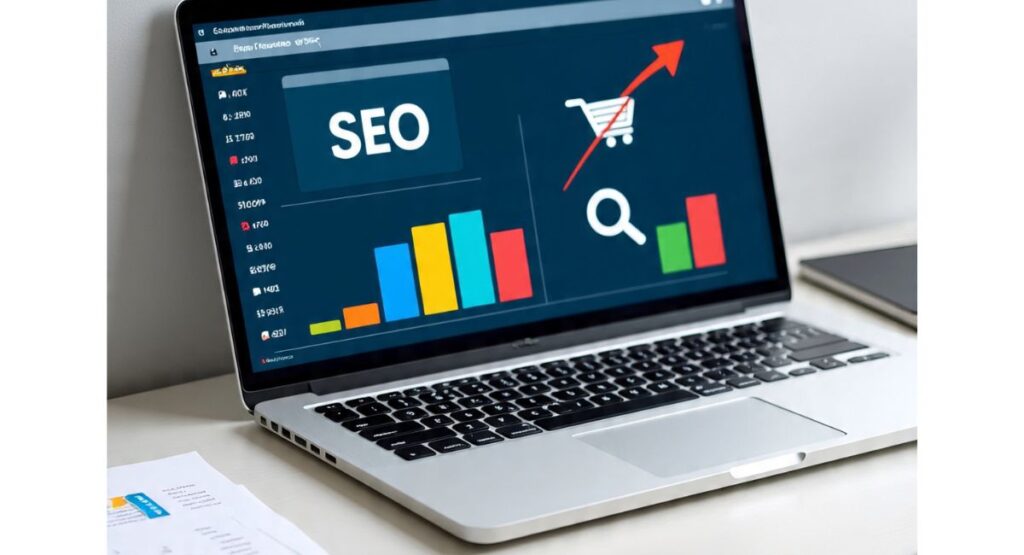Are you struggling to gain visitors to your store online? Don’t worry, you’re not the only one.
Every ecommerce business owner comes across an obstacle: you’ve put together an excellent store, but your site isn’t visible on Google. This is the point where SEO for an e-commerce website is a strong, long-term strategy to assist your products to be more prominent, boost organic traffic, and, more importantly, increase sales without advertising.
This is a step-by-step guide, packed with practical techniques, professional tools, and real-world information. You’ll be able to learn all about keyword research to the speed of your site, as well as content strategy and the art of conversion rate optimization (CRO).
Let’s get started.
- Ecommerce SEO Expert Advice: What Is Ecommerce SEO and Why Does It Matter
- Ecommerce SEO RankStar Strategy: Start With Smart Keyword Research
- SEO for Ecommerce Websites: Optimizing Product Pages for Search
- Ecommerce Store SEO Essentials: Homepage Optimization
- Ecommerce Business SEO Structure: Organize Your Site Like a Pro
- How to Do SEO for an Ecommerce Site Blog and Supporting Pages
- Mobile Ecommerce SEO: Use Responsive Design
- Improve Page Speed for Better SEO and Conversions
- Internal Linking Strategy: Build SEO and Increase Time on Site
- Backlink Building for Ecommerce SEO
- SEO and CRO: A Winning Combo for Your Store
- SEO Checklist for Ecommerce Stores
- FAQs
Ecommerce SEO Expert Advice: What Is Ecommerce SEO and Why Does It Matter
SEO for ecommerce is the method of optimizing your store’s online presence to ensure it is ranked better in search results for terms that are relevant to your product. Instead of relying solely on costly advertisements, SEO helps bring in constant and free traffic.
Here’s the reason why it’s so important:
- 67% of clicks are directed to one of the top five results organically (source)
- SEO is a major driver of 1,000% or higher traffic than social networks that are organic (BrightEdge Study)
Real-Life Insight
When Lisa, the eco-friendly bag seller, optimized her shop for keywords such as “reusable cotton totes,” her monthly traffic increased from 400 to 5,200 in just six months. This was with no ad spending.
That’s the power behind SEO for eCommerce websites.
Ecommerce SEO RankStar Strategy: Start With Smart Keyword Research
Effective SEO starts with the appropriate keywords – what your clients actually type into Google.
Step-by-step:
- Make use of Ubersuggest and Ahrefs to locate Keywords with high volumes, but low competition.
- Long-tail keywords should be targeted, such as “best waterproof hiking boots for women.”
- Know the intent of the search–is the user searching to purchase or learn more, or do they want to compare?
Pro Tip: Find out where your competitors rank by using SEMrush.
The most prominent placements for your keywords:
- Product titles
- Meta titles & descriptions
- URLs
- Image alt text
- Header tags (H1 H2s, H1)
Do you want to get deeper? Here’s the comprehensive tutorial on keyword research.
SEO for Ecommerce Websites: Optimizing Product Pages for Search
Every product page offers SEO opportunities. Do not just give some specs and a price. Instead, treat every page as an actual landing page.
Optimize:
- Product titles: Include your main keyword (e.g., “Handmade Ceramic Coffee Mug”)
- Meta descriptions: Summarize benefits + keyword + CTA
- Descriptions: Avoid manufacturer copy. Write your own with an approachable, friendly tone.
- Images: Compress to speed, use descriptive filenames, and then add alt tags.
Add:
- FAQs: Prepare for and respond to buyer queries.
- Reviews: Increase confidence and trust by generating content from users.
- Videos: Show how to use or unboxing.
For ideas, take a look at the way ASOS organizes its product pages.
Ecommerce Store SEO Essentials: Homepage Optimization
Your homepage is like a storefront window. Google is attentive to it and also to your customers.
Here’s how to make it more efficient:
- Create a clear H1 using your primary keyword and brand name.
- Create a descriptive meta description with keywords.
- Highlight your most popular categories by using internal hyperlinks.
- Mention your unique selling proposition (USP) early.
Want examples? Look at Warby Parker’s SEO homepage.
Ecommerce Business SEO Structure: Organize Your Site Like a Pro
A messy website can confuse Google and the users. Cleanliness improves indexing, crawling, and UX.
Best practices:
- Use breadcrumbs for navigation.
- Structure URLs like: /category/product-name.
- You can keep everything in 3 clicks of the home page.
- Include internal hyperlinks to help Google (and the users) navigate your web pages.
Structure example:
Home > Men’s Shoes > Running > Nike Air Zoom
Find out more about the site’s architecture to aid in SEO.
How to Do SEO for an Ecommerce Site Blog and Supporting Pages

SEO isn’t only for product pages. Establish authority and gain early-stage interest by providing helpful blogs that are full of content.
Ideas:
- Buying guides (e.g., “Best Kitchen Knives Under $100”)
- Tutorials (“How to Style a Midi Skirt”)
- Comparisons (“Steel vs Ceramic Cookware”)
- FAQs and How-To articles
Every blog post should be linked to appropriate products, increasing both conversions and traffic.
Read: How ecommerce content marketing drives sales.
Mobile Ecommerce SEO: Use Responsive Design
More than 60% of online shopping is now done via mobile. If your site isn’t working on a mobile device and you’re not getting rankings.
Check your website:
- Fast loading on 4G
- Menus that are mobile-friendly
- Doesn’t cut off images or text
- Passes Google’s Mobile-Friendly Test
Improve Page Speed for Better SEO and Conversions
Slow websites kill rankings and keep people from returning.
Optimize:
- Compress images using TinyPNG.
- Make use of lazy loading to load images.
- Select themes that are light.
- Beware of unnecessary scripts and plugins.
Test your website using PageSpeed Insights.
Internal Linking Strategy: Build SEO and Increase Time on Site
Internal linking is not only beneficial for navigation, but also assists Google in understanding what your website is about.
Link:
- Posts on blogs to products
- Products to similar products
- Categories to subcategories
Use anchor words that are descriptive (e.g., “shop hiking gear” instead of “click here”).
Backlink Building for Ecommerce SEO
Backlinks are the links that link other websites to yours. They’re among Google’s top ranking signals.
How to get them?
- Guest blog post on blogs in your area of expertise
- Send testimonials to your partners.
- Create content that can be shared (infographics or guides)
- Get in touch with influential people or host contests.
Verify your backlink profile using Moz Link Explorer.
SEO and CRO: A Winning Combo for Your Store
SEO attracts visitors to your website, but CRO converts them into customers.
Utilize tools like Hotjar and Crazy Egg to track:
- Click maps
- Scroll depth
- Form drop-off
A/B test:
- Button colors
- Headlines
- Product images
- CTAs
A small 1% improvement in conversion rate can make a huge difference in profits.
SEO Checklist for Ecommerce Stores
| Task | Importance |
| Keyword research | Foundation |
| Optimize product pages | Critical |
| SEO your homepage | High |
| Improve site structure | Medium |
| Add non-product content | High |
| Improve page speed | Critical |
| Use responsive design | Essential |
| Add internal links | High |
| Encourage reviews & FAQs | High |
| Use optimized images & video | Medium |
| Build quality backlinks | Critical |
| Implement CRO strategies | Essential |
SEO for ecommerce site is not a magic switch—but a long-term investment that pays off in organic traffic, higher conversions, and brand trust.
Start with your most important product pages. Then expand to your homepage, blog, and categories. Always test, tweak, and improve.
With smart tools, helpful content, and a commitment to your audience, your store can climb the rankings—and stay there.
FAQs
1. How do I SEO my ecommerce website?
Start by optimizing product pages, improving site speed, and using the right keywords. If you’d prefer expert help, SEOguestPro offers professional ecommerce SEO services.
2. What are the 4 types of SEO?
The four main types are on-page SEO, off-page SEO, technical SEO, and local SEO—each important for visibility and ranking.
3. Can I do SEO by myself?
Yes, you can learn and apply SEO basics on your own using tools like Google Search Console and Ubersuggest
4. What is the best ecommerce website for SEO?
Shopify, WooCommerce, and BigCommerce are among the best platforms for SEO due to their flexibility and optimization features.

I’m SEO expert and content writer at SEO Guest Pro.
I help websites rank higher, get more traffic, and grow fast using smart SEO and engaging content.
Let’s grow together!

